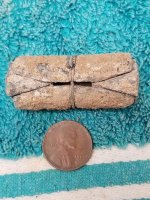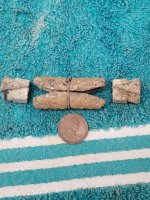It's made of some sort of non-ferrous white metal. The expandable band around the center is steel and the ends lock in place to the center pieces. The ends are threaded and if you push them toward each other, it will expand the outside diameter of the center section. Anyone recognize it?
Navigation
Install the app
How to install the app on iOS
Follow along with the video below to see how to install our site as a web app on your home screen.
Note: This feature may not be available in some browsers.
More options
You are using an out of date browser. It may not display this or other websites correctly.
You should upgrade or use an alternative browser.
You should upgrade or use an alternative browser.
🔎 UNIDENTIFIED Coupler or anchor of some kind?
- Thread starter cudamark
- Start date
Retired Sarge
Silver Member
No clue, but cool as hell. Just posting so I can learn what it is also......
Upvote
2
- Jun 8, 2006
- 6,267
- 8,861
- Detector(s) used
- Whites, Minelab, Tesoro, and custom machines
- Primary Interest:
- Metal Detecting
I've seen several types of expanders but none like that..It's made of some sort of non-ferrous white metal. The expandable band around the center is steel and the ends lock in place to the center pieces. The ends are threaded and if you push them toward each other, it will expand the outside diameter of the center section. Anyone recognize it?
Upvote
1
crashbandicoot
Gold Member
I think you,re on the right track.I hope someone can ID it as I,m really curious.
Upvote
0
its a lead anchor

 www.confast.com
www.confast.com

3/8" Double Expansion Anchor, 30/Box
Buy the 3/8" Double Expansion Anchor on line for huge savings and highest quality; orders ship the same day and freight is free.
 www.confast.com
www.confast.com
Upvote
7
- Thread starter
- #7
It's not lead, but, going by 50bmg's link, it's probably a masonry anchor. I've used lots of them over the years, but, never one like this one. I guess it would be for an application that needed an anchor on both sides of a wall? Otherwise, why would you need a threaded end on both sides. All the ones I've used were ones that went into a blind hole and expanded as you turned the nut or bolt. I can't figure out how it would operate with a bolt on both sides. The ends need to squeeze together to expand. Maybe that's why this one was lost or thrown away. I may have been assembled with two threaded ends instead of one. If one end had a slightly bigger hole and no threads, you could use a bolt or stud/nut to pull the ends together.
Upvote
2
I call them lead anchors all the time at work because we replaced the actual lead ones with them. they are actually made out of a zinc alloyIt's not lead, but, going by 50bmg's link, it's probably a masonry anchor. I've used lots of them over the years, but, never one like this one. I guess it would be for an application that needed an anchor on both sides of a wall? Otherwise, why would you need a threaded end on both sides. All the ones I've used were ones that went into a blind hole and expanded as you turned the nut or bolt. I can't figure out how it would operate with a bolt on both sides. The ends need to squeeze together to expand. Maybe that's why this one was lost or thrown away. I may have been assembled with two threaded ends instead of one. If one end had a slightly bigger hole and no threads, you could use a bolt or stud/nut to pull the ends together.
they do go into a blind hole and only 1 side is threaded. the 2 wedge shaped pieces pull together when tightened to expand the anchor in the hole.
Upvote
3
boogeyman
Gold Member
- Jun 6, 2006
- 5,016
- 4,402
- Detector(s) used
- WHITES, MINELAB, Garrett
- Primary Interest:
- All Treasure Hunting
Ding ding ding! There's tour winner!its a lead anchor

3/8" Double Expansion Anchor, 30/Box
Buy the 3/8" Double Expansion Anchor on line for huge savings and highest quality; orders ship the same day and freight is free.www.confast.com
Upvote
1
Top Member Reactions
-
 3448
3448 -
 1965
1965 -
 1908
1908 -
 1148
1148 -
 1089
1089 -
 1006
1006 -
 876
876 -
 861
861 -
 860
860 -
 776
776 -
 757
757 -
 676
676 -
 653
653 -
 567
567 -
 504
504 -
 451
451 -
 447
447 -
 410
410 -
 403
403 -
E
398
Users who are viewing this thread
Total: 2 (members: 0, guests: 2)





